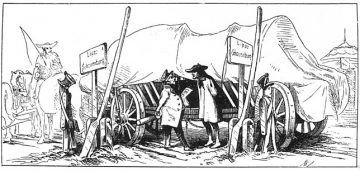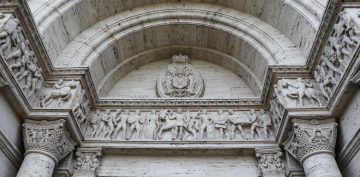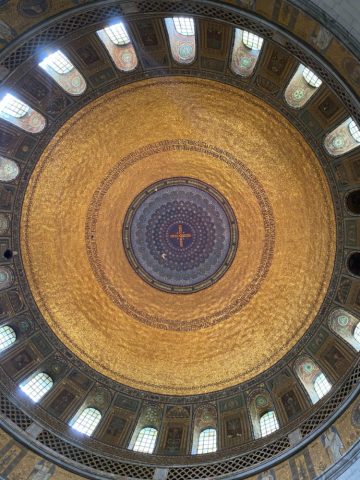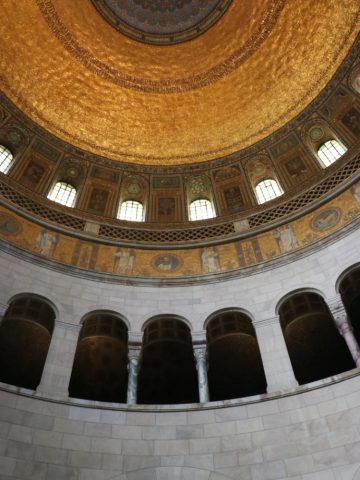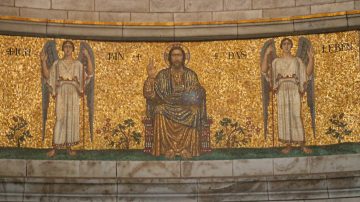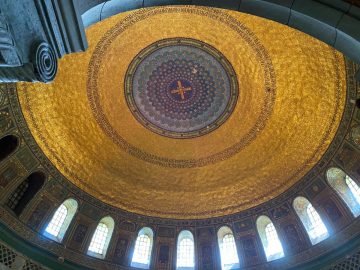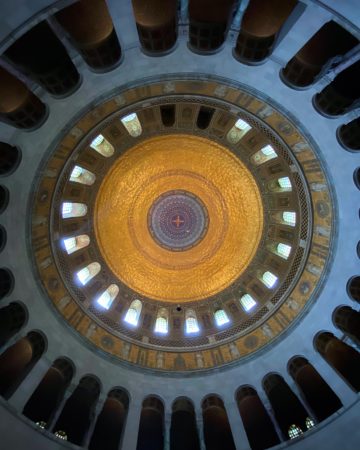The Mausoleum of the Schaumburg-Lippe family in Bückeburg in Lower Saxony near Hannover in Germany is the largest private mausoleum in Europe.

The County of Schaumburg-Lippe was the smallest state in the German Empire, which did not prevent its ruling house from building the largest private mausoleum in Europe in its capital Bückeburg. The neo-Romanesque mausoleum was completed during the First World War and is decorated with Byzantine-style mosaics — the dome mosaic is the largest in Europe outside Istanbul. The Schaumburg-Lippe family mausoleum is in the gardens of the Schloss Bückeburg and only open for visitors on weekends.
Schaumburg-Lippe Family in Bückeburg
The County of Schaumburg-Lippe with Bückeburg as the capital city was founded in 1647 when it was carved out of the County of Schaumburg that existed since 1106 but had to be divided when the Schaumburg family became extinct. The Lippe side of the family equally traces its noble history back to the early 12th century and is still in existence. (Queen Beatrix of the Netherlands was a Lippe but preferred to keep the name Orange-Nassau.)
Six different counts of Schaumburg-Lippe ruled the county until it was elevated to a principality (Fürstentum) in 1807 when it joined Napoleon’s Rheinbund. The count (Graf) became a sovereign prince (Fürst) and had the title confirmed when joining the Deutsche Bund in 1815 and later became the smallest state by population in the German Empire (1871-1918).
Four Fürsten ruled Schaumburg-Lippe before Fürst Adolf II, who built the mausoleum, abdicated on 15 November 1918 — one of the last German princes to accept the end of the monarchy at the end of the First World War. Schaumburg-Lippe remained a free state in the Weimar Republic and only cease to exist as an independent state when forced to become part of the new super state Lower Saxony by the British occupying forces in 1946.
Bückeburg was a small town and the principality of Schaumburg-Lippe not much bigger. A cartoon from 1834 showed a wagon sticking out on both ends beyond Schaumburg-Lippe border posts with the question: is the wagon too big or the principality too small? It was a protest against small German states hindering trade by claiming import duties on wares simply moving through to larger entities.
Fürst is usually translated in English as prince or sovereign prince, as it has no direct equal in the English system. A Fürst rules over a Fürstentum (principality) — his children and non-ruling senior members of the family are princes. The term is still used currently for the rulers of for example Liechtenstein and Monaco. In order of precedence, a Fürst comes after a duke (Herzog) but before a margrave (Markgraf).
Schaumburg-Lippe Mausoleum in Bückeburg
Schloss Bückeburg, surrounded by a moat and a large English landscape style park was the principal residence of the House of Schaumburg-Lippe from its foundation to the present. The family mausoleum was erected in the park between 1911 and 1915 by Fürst Adolf II following the death of his father Georg. It was the last major Romanesque revival structure built in Germany.
Loosely inspired by the Parthenon in Rome and the Kaiserdom in Aachen, the mausoleum was designed by Paul Baumgarten in a neo-Romanesque style. It consists of two main spaces: the classical entrance hall and the dome-covered main hall. At 43 m high and 27 m wide it is the largest mausoleum in Europe and the largest in the world still in private use. (It Is far bigger than the Mausoleum of the House of Hannover built at Herrenhausen only a few decades earlier.)
The facade of the mausoleum is of light-colored travertine but most of the rest of the building is from local sandstone with a copper dome topped by a wrought iron cross.
The reliefs above the entrance show the nobles at the center with homages to soldiers, hunters, and horsemen to the left and arts, commerce, and agriculture on the right. The capitals and main doors are mostly decorated with the symbols of the four evangelists and other religious details. The Schaumburg-Lippe family coat of arms is in the semi-circular tympanum.
Portal (Vorhalle)
In the portal, beyond the ticket window, is a small exhibition but the main works to see here are two large 17th-century paintings: Hagar in the Dessert by Dutch artist Gerrit van Honthorst and John Preaching in the Dessert by Italian painter Lorenzo Pasinelli.
From the portal, stairs lead up to the gallery — absolutely worth the easy climb — while a further door gives access to the crypt — not open to the public — where the actual family sarcophagi are positioned.
Dome Hall (Kuppelhalle)
The vast dome hall has colorful Byzantine-style mosaic decorations beautifully lit through the ring of windows high up just below the dome.
As could be expected from a round building, the decorations are in horizontal rings. On the ground level, the ten pillars allow for eight alcoves, an altar room, and the entrance. The second level has a gallery followed by a mosaic ring decorated with angels and biblical figures, the ring of windows with further mosaics on the frames, and finally topped off by the mosaic on the dome.
The mostly golden mosaic with a cross at the center that covers the entire dome is at 500 m2 the largest in Europe outside Istanbul. This amazing mosaic has more than 1400 different color tints. The slight damage was caused by a grenade at the end of the Second World War.
The mosaics were clearly inspired by Byzantine art, both in Constantinople and other cities such as Ravenna in Italy, that was very popular in Imperial Germany. It inspired for example the mosaics in the Kaiserdom in Aachen and the Erlöserkirche in Bad Homburg.
Graves of the Schaumburg-Lippe Family
The eight alcoves on the ground floor were intended for the sarcophagi of the senior members of the Schaumburg-Lippe family. Most of the floor areas here are undecorated as the intention was that each member could select their own mosaic design.
However, due to the end of the monarchy in 1918, the sarcophagi were never placed here and are now in the crypt of the mausoleum (not open to the public). Currently, the remains of 18 family members are interned in the crypt with a further eight in the private cemetery behind the mausoleum.
The only alcove fully decorated is the altar room with its large mosaic of Christ and angels. The crucifix here is from the 13th century and the bible from 1628.
The alcove to the left of the altar was designed for Adolf II (1883-1936), the last ruling Fürst of Schaumburg-Lippe. He died together with his wife (and 12 others) in an aircraft crash in Mexico. His youngest brother, Friedrich Christian, tried to prevent the interment in the mausoleum of Adolf’s wife due to her un-Arian heritage. Friedrich Christian joined the Nazi Party in 1929, one of the first German nobles to have done so, and was an assistant of Goebbels.
Adolf II was succeeded as head of the family by his brother Wolrad (1887-1962), who joined the Nazi Party only in 1936 but backdated to 1928. The alcove to the right of the altar room has a cross for his son who died only days before the end of the Second World War.
Both brothers escaped the consequences of their actions during the war with a relatively mild Category IV classification as supporters of the Nazi regime. While Wolrad seemed to have concentrated on business following the war, Friedrich Christian (1906-1983) remained an active writer who never denounced the Nazi regime. His writings were popular in far-right circles but dismissed as unreliable by academics.
Visitors Information for the Bückeburg Mausoleum
The Bückeburg Mausoleum is only open on weekends and holidays from 11:30 to 16:30, closing at 17:30 from April to October.
Admission is €4 (€2.50 for children under 16) and €8 if a guided tour is taken. Combination tickets are available with the palace, which may only be seen on guided tours.
The Mausoleum is located inside the Schlosspark — an English-style landscape park that is freely open. It is a pleasant 15-minute walk from the bridge leading the Schloss. En route, pass by the tennis club, and the pleasant Lilly’s Brasserie with beer garden.
See also Top Sights to Visit in Bückeburg for more on the palace and further attractions in the old town, including the Weser-Renaissance Stadtkirche, and on transportation to Bückeburg near Hannover.

